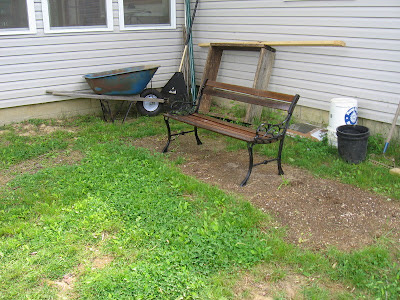I got back home on April 5 after visiting family in south Texas. I left on Monday morning, March 26 and drove across Missouri, NW Arkansas and Oklahoma, and traversed Texas north to south on the way to the Rio Grande Valley. I expected Missouri to be midwestern with lots of farms. It’s much hillier than I thought, and most of the country along I-44 is wooded – the Missouri Ozarks. The Boston Mountains south of Fayetteville Arkansas are beautiful – just big enough to be mountains, not hills – with a lot of sweeping vistas. Oklahoma seemed desolate, poor. Dallas is huge, monster freeway interchanges, densely structured. I took US 77 through central Texas and camped at a State Park, the next morning stopped at a Czech bakery in LaGrange for breakfast tacos and Kolaches – food of the gods in my opinion. If you ever find yourself on the byroads in this part of Texas look for one of these bakeries, you won't regret it.
So what happens when I leave a garden plot for 10 days in the spring to its own devices? The day before leaving I transplanted a set of cole crops into the beds – broccoli, kohlrabi and pak choi. Cutworms got the broccoli and damaged the others. I bought a 4-pack of broccoli seedlings at the greenhouse and planted 2 of them in the bed. The next day the cutworms went to work on one of the new broccoli seedlings. I planted one of the remaining seedlings in its place, put a collar around it from a paper towel tube and doused the soil around all the seedlings with Bt. So far so good.

The day before I left I seeded a set of cole crops under the lights. Another set of cole crops had been planted on March 12 and was just beginning to show true leaves. The seed-starting system uses a wicking mat in a perforated tray that sits in a reservoir tray, which I believed would provide enough water while I was gone, and the lights are on a timer. When I got back I found that the seedlings that were already up when I left had not grown at all. The plants that were seeded the day before I left had germinated and were already larger than the previous set. In the picture, the set of plants that was seeded on March 12 is on the right, the set that was seeded March 25 is on the left. The leeks were in bad shape as well.

Why did the older seedlings just stop growing? Here's my theory. Extra water was added to the reservoir tray before I left so there was some standing water above the mat. The soil mix got too wet and the seedlings drowned. By the time the next set of seedlings germinated the excess water had evaporated and the moisture level in the soil was better. So the newer set of seedlings did fine, the older seedlings drowned. If that's not it it's time to go into the paranormal.
On the plus side the plants in the greens bed thrived. The homemade cage over the bed kept out any critters (rabbits) that consider greens a tasty meal. I picked some of the larger lettuce plants and reseeded the open spots with more lettuce.
A spinach plant (Space) was harvested, as well as the first row of radishes. I seeded more spinach (Renegade, a fast maturing variety) where the radish grew. Then I took two young spinach plants that needed to be thinned out and transplanted them to the spot where the spinach plant was removed. The first set of broccoli, kohlrabi and pak choi is doing well. That purple pak choi is really a beautiful plant.
A half-wheelbarrow load of compost was applied to the parsnip/leek/okra bed. It may need some fertilizer, but parsnips do a good job of bringing up nutrients. I turned over the soil by shovel, rototilled the top few inches and raked smooth. Six rows of parsnips were seeded then the soil surface was dusted with a little sulfur, which I would like to think deters the squirrels from digging. This year I tried Lancer parsnips instead of Harris Model, which is usually what you find in stores. This bed was full of cilantro volunteers before it was dug up and I saved a few of them in pots.
Not much more work needs doing in the beds for a week or two. Potatoes are scheduled to go in April 18 but I might move that time up a week since all plants are about two weeks ahead of schedule this year. I’d like to see the compost in the bin finish out a little more before digging it into the beds. With 3 beds mostly planted there should be enough compost to apply about an inch over the remaining 4 beds.
For the week I got spinach 10 oz, lettuce 20 oz, and radish 7 oz. So far this year the beds have produced: parsnip 7.6 pound, leek 1.5 pound (both planted last year), lettuce 2.5 pound, spinach 1.4 pound, radish 0.4 pound. Total 13.4 pounds for the year. Off to a good start.



























